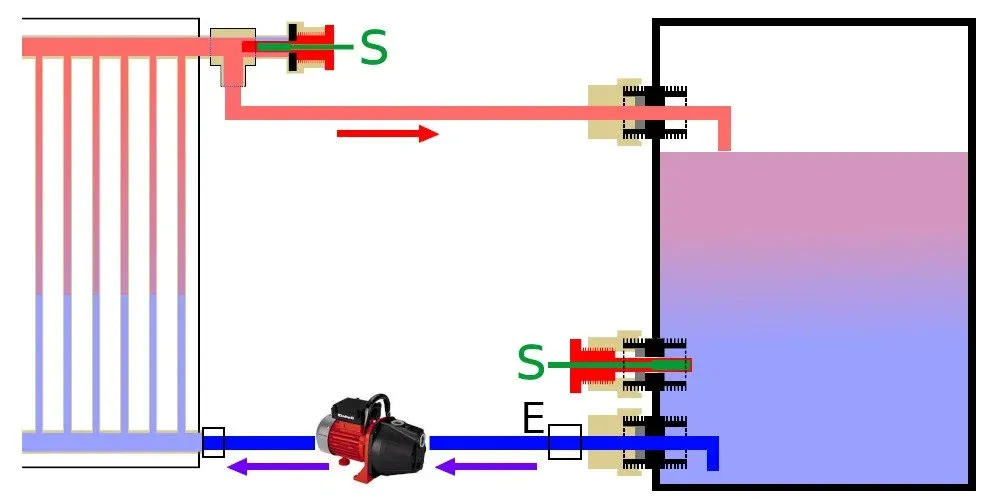
If your homemade solar heater design is going to work by thermosiphon, you won't need to know anything about forced circulation with a water pump.
Forced circulation with a water pump is obviously done with a water pump, did you doubt it? :-D
I'll briefly explain what would be very easy to understand with the graphic illustration in the following photo:
As marked in the previous photo, with the letter "E", here we can install a solenoid valve or return valve.
The purpose of both devices is the same.
It is to prevent water from circulating when the pumping process is stopped.
When the device that manages the pumping, normally a differential thermostat, is not activating the pump, it is because the temperatures of the collector and tank do not meet the necessary or ideal requirements for them to exchange water.
But it can happen and it does happen that in cold conditions (such as at night) there will be a situation in which the tank will be hot, and the collector cold. (The opposite of what is usually the day)
Then a natural thermosiphon circulation suddenly arises, due to the temperature differences, in which the movement of the water will go from the hottest place (tank) to the coldest place (collector).
Which is the opposite of what we want.
This circumstance is easily avoided by stopping the passage of this circulation.
And in order to carry out this solution, we need an appropriate device for it.
This is a check valve:
The check valve offers us this "stop" in a simple way without the need for any electronic device.
It allows the passage of water in one direction, and stops it in the opposite direction.
This is a solenoid valve:
The solenoid valve is a more modern device. It consists of a membrane that allows or stops the passage of water depending on whether we activate it or not by applying an electric voltage.
There are various types of solenoid valves, alternating current or direct current.
This solenoid valve must be connected to a device that activates it when it is necessary for the water to flow or stop.
The function and purpose is exactly the same as the non-return valve, but its mechanism is completely different.
Circulation will be when the drain pipe that brings water from the collector is not submerged.
Then the water pours into the tank, it falls in gushes, like a faucet.
The "S" represent the probes (although it is not related to the topic, it is something that will be present)
The water between the tank and the collector will be moved by the pump, which will suck the lower part of the tank, and push it to the lower part of the collector.
This flow and water pressure will push the water in the collector upwards, forcing it to leave the collector.
Finally, the water leaving the collector inevitably ends up in the tank.
And so on repeatedly until the water pump stops.
At this point, it is assumed that it is understood that the pump will only work when the water in the collector is hot enough to provide its temperature to the tank.
Recirculation will occur when the drain pipe that brings water from the collector is completely submerged in the water in the tank.
The installation that I made on the roof had the tank and collector at the same level.
But as this roof had no access and I had to climb up a ladder to a height of 6 metres, I lowered the water pump to a window with the idea of being able to operate it if I had problems.
The water pump would be about 2.5 meters down, and although the water flow was level, it did need pressure to move the water.
The pump used in this project was this one:
It is a centrifugal pump with a brushless motor, specially designed for very hot water (up to 100ºC).
It is an extremely quiet pump whose electrical consumption does not exceed 10W.
At the time I started this project, it was very difficult to find this type of pump, and I did not want to use large, complex pumps with high electrical consumption.